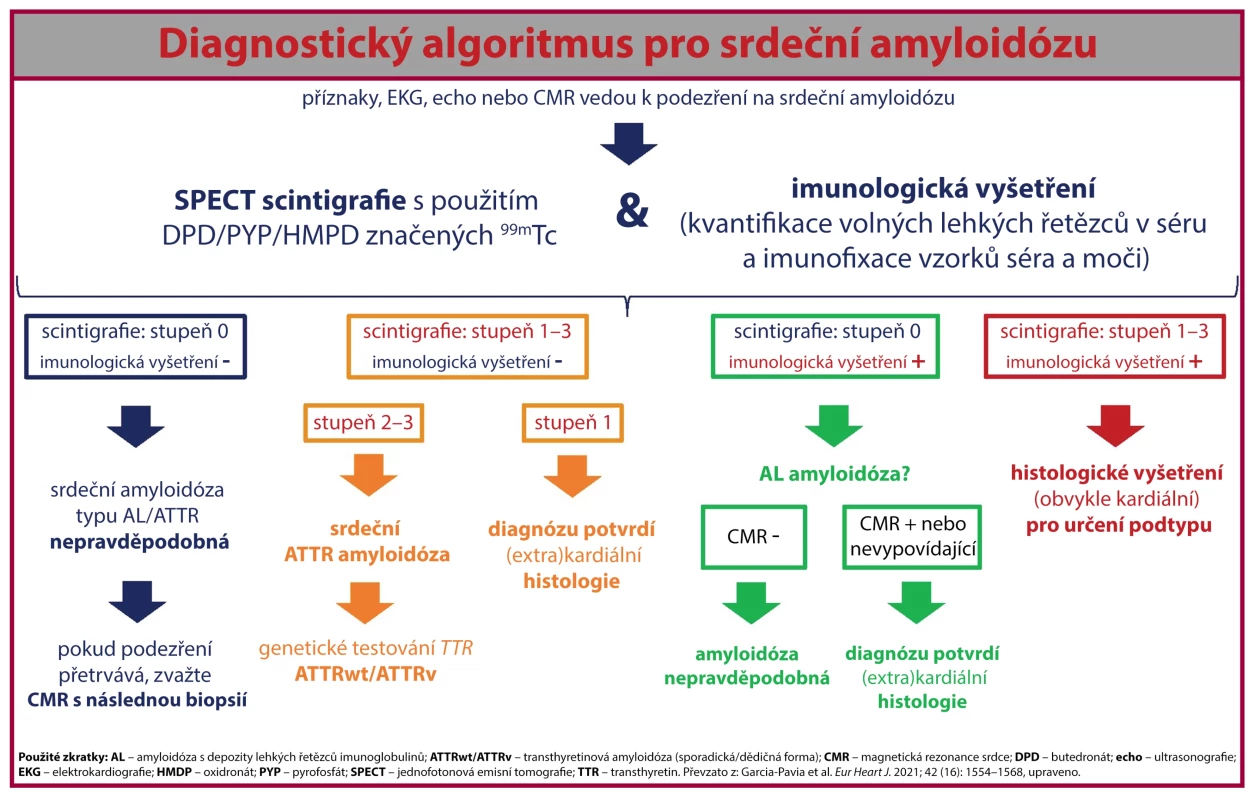INFOGRAPHIC: Diagnostic Algorithm for Cardiac Amyloidosis
What examinations are needed when cardiac amyloidosis is suspected? Which tests can distinguish transthyretin amyloidosis from systemic disease caused by immunoglobulin light chains? We bring you a clear diagnostic scheme according to the recommendations of the European Society of Cardiology (ESC). .
Suspicion of Systemic Amyloidosis
Cardiac amyloidosis typically appears along with a set of extracardiac symptoms, which, in conjunction with the typical cardiac manifestations, may lead us to suspect this disease. These are known as red flags, which include proteinuria, macroglossia, easy bruising, or carpal tunnel syndrome in history.
If amyloidosis is suspected, a definitive diagnosis should be reached as soon as possible, as the prognosis of patients depends on the timely initiation of treatment.
Diagnosis
Given that most cardiac amyloidoses arise from the accumulation of immunoglobulin light chains (AL) or transthyretin (TTR), the European Society of Cardiology (ESC) has developed an algorithm specifically focused on diagnosing these subtypes.
The proposed non-invasive diagnostic procedure uses scintigraphic examination with radiopharmaceuticals labeled with the technetium isotope (99mTc). 99mTc-pyrophosphate (PYP), -butedronate (DPD), or -oxidronate (HMDP) can be used. Furthermore, monoclonal protein testing should be performed – quantification of free light chains in serum and electrophoresis with immunofixation from protein samples in serum and urine.
Depending on whether cardiac uptake of the radiopharmaceutical is observed on scintigraphy and the results of monoclonal protein tests, four possibilities can arise (see infographic):

- Scintigraphy shows no cardiac uptake and monoclonal protein tests are negative: Cardiac amyloidosis is unlikely, and an alternative diagnosis should be considered. If suspicion persists, consider cardiac MRI (CRM) followed by a biopsy (cardiac or extracardiac). In some variants of hereditary ATTRv or rare subtypes of cardiac amyloidosis, bone scintigraphy may be negative.
- Scintigraphy shows cardiac uptake and monoclonal protein tests are negative: If the observed uptake is grade 2–3, it is cardiac ATTR amyloidosis, and genetic testing should proceed to determine the form of the disease. If the observed uptake is grade 1, non-invasive diagnosis is not possible, and histological confirmation of amyloid deposits (extracardiac if necessary) is required for diagnosis.
- Scintigraphy shows no cardiac uptake and at least one monoclonal protein test is positive: AL amyloidosis should be excluded immediately. If CRM does not indicate cardiac amyloidosis, the diagnosis is very unlikely. If CRM indicates amyloidosis or is inconclusive, histological confirmation of amyloid deposits in biopsies of affected organs is necessary. Consultation with a hematologist is advisable. If timely CRM examination is not possible, consider immediate biopsy.
- Scintigraphy shows cardiac uptake and at least one monoclonal protein test is positive: Diagnosing cardiac amyloidosis in this case requires histological examination with typing of amyloid deposits, usually via endomyocardial biopsy.
Conclusion
We should consider cardiac amyloidosis in patients with increased thickness of the heart wall and the presence of cardiac or extracardiac warning signs (red flags) and/or in specific clinical situations. The correct diagnosis can be determined according to the diagnostic algorithm using scintigraphy and monoclonal protein testing.
(este)
Source: Garcia-Pavia P., Rapezzi C., Adler Y. et al. Diagnosis and treatment of cardiac amyloidosis: a position statement of the ESC Working Group on Myocardial and Pericardial Diseases. Eur Heart J. 2021; 42 (16): 1554–1568, doi: 10.1093/eurheartj/ehab072.
Did you like this article? Would you like to comment on it? Write to us. We are interested in your opinion. We will not publish it, but we will gladly answer you.
